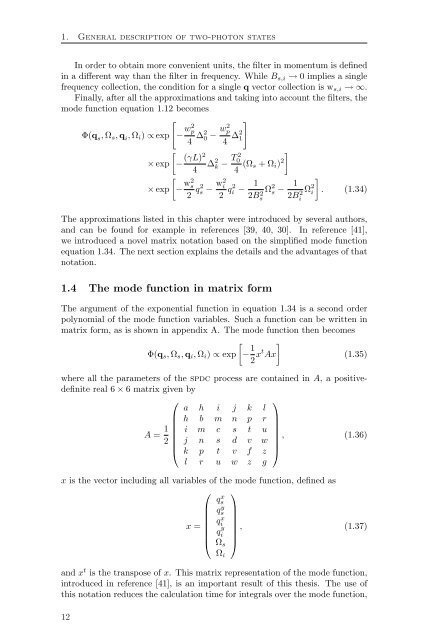Spatial Characterization Of Two-Photon States - GAP-Optique
Spatial Characterization Of Two-Photon States - GAP-Optique
Spatial Characterization Of Two-Photon States - GAP-Optique
Create successful ePaper yourself
Turn your PDF publications into a flip-book with our unique Google optimized e-Paper software.
1. General description of two-photon states<br />
In order to obtain more convenient units, the filter in momentum is defined<br />
in a different way than the filter in frequency. While Bs,i → 0 implies a single<br />
frequency collection, the condition for a single q vector collection is ws,i → ∞.<br />
Finally, after all the approximations and taking into account the filters, the<br />
mode function equation 1.12 becomes<br />
<br />
<br />
Φ(qs, Ωs, qi, Ωi) ∝ exp − w2 p<br />
4 ∆20 − w2 p<br />
4 ∆21 <br />
× exp − (γL)2<br />
4 ∆2k − T 2 0<br />
4 (Ωs + Ωi) 2<br />
<br />
<br />
× exp − w2 s<br />
2 q2 s − w2 i<br />
2 q2 i − 1<br />
2B2 Ω<br />
s<br />
2 s − 1<br />
2B2 Ω<br />
i<br />
2 <br />
i . (1.34)<br />
The approximations listed in this chapter were introduced by several authors,<br />
and can be found for example in references [39, 40, 30]. In reference [41],<br />
we introduced a novel matrix notation based on the simplified mode function<br />
equation 1.34. The next section explains the details and the advantages of that<br />
notation.<br />
1.4 The mode function in matrix form<br />
The argument of the exponential function in equation 1.34 is a second order<br />
polynomial of the mode function variables. Such a function can be written in<br />
matrix form, as is shown in appendix A. The mode function then becomes<br />
<br />
Φ(qs, Ωs, qi, Ωi) ∝ exp − 1<br />
2 xt <br />
Ax<br />
(1.35)<br />
where all the parameters of the spdc process are contained in A, a positivedefinite<br />
real 6 × 6 matrix given by<br />
A = 1<br />
⎛<br />
a<br />
⎜ h<br />
⎜ i<br />
2 ⎜ j<br />
⎝ k<br />
h<br />
b<br />
m<br />
n<br />
p<br />
i<br />
m<br />
c<br />
s<br />
t<br />
j<br />
n<br />
s<br />
d<br />
v<br />
k<br />
p<br />
t<br />
v<br />
f<br />
l<br />
r<br />
u<br />
w<br />
z<br />
⎞<br />
⎟ ,<br />
⎟<br />
⎠<br />
(1.36)<br />
l r u w z g<br />
x is the vector including all variables of the mode function, defined as<br />
⎛ ⎞<br />
⎜<br />
x = ⎜<br />
⎝<br />
q x s<br />
q y s<br />
q x i<br />
q y<br />
i<br />
Ωs<br />
Ωi<br />
⎟ , (1.37)<br />
⎟<br />
⎠<br />
and x t is the transpose of x. This matrix representation of the mode function,<br />
introduced in reference [41], is an important result of this thesis. The use of<br />
this notation reduces the calculation time for integrals over the mode function,<br />
12



